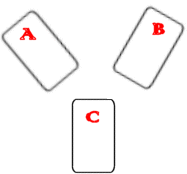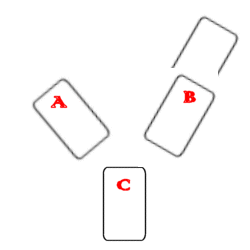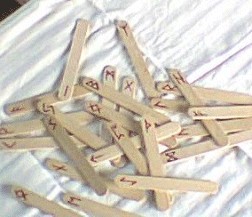So, with all that said, now shuffle, shake, or whatever you do to mix up your set of rune-staves. We are going to draw staves to cover three (3) positions in a 3-stave or Nornic layout. Ordinarily, that means drawing 3 staves; however, if you have included a blank stave in your set and happen to draw the blank one during this exercise, it means that you will need to draw a total of four (4) staves, including the blank.
We shall assume, for the moment, that you have prepared a well-thought-out Query, avoiding set-ups for yes-or-no answers (which you will not get), as well as asking only in terms of Now. A good basic model to use is "What do I need to know about..." and then avoid beclouding the issue with your own prejudices, judgements, expectations, or assumptions. An example might be, "What do I need to know to help me better follow the path I have chosen?" (instead of "Will I be successful?"). Get the idea?
So let's imagine that you have just done this blind-drawing of three rune-staves, and the results look like the diagram below:
 The names of the three positions of the layout are deceptively simple: A = Past (Urdhr), the Crone; B = Present (Verhandi), the Maiden; and C = Future (Skuld), the Mother. I do not want you to be deceived, so let's examine each of these rather carefully.
The names of the three positions of the layout are deceptively simple: A = Past (Urdhr), the Crone; B = Present (Verhandi), the Maiden; and C = Future (Skuld), the Mother. I do not want you to be deceived, so let's examine each of these rather carefully.
The first rune-stave you draw, which you place on Position A, carries some information about contributions of the Past to the Present process, or about Urdhr the Crone and how she interacts with and influences the Maiden, Verhandi, the Present. This rune can also clarify the real root of the present situation, or perhaps a novel consideration or set of factors in what you 'thought' was / is 'the Problem'.
 Always remember that when we talk about the interactions of Urdhr, Verhandi and Skuld, we are talking about you and the Subject of your Query. In a runic spread, 'The Past' refers not only to your remembered or documented personal past, but also to all the events and influences (known to you or not) that have shaped, shifted and stirred you to produce the 'you' that arrives in The Present. It can also refer to or include your 'present' attitudes, preferences, judgments and prejudices that you bring with you from that 'past'.
Always remember that when we talk about the interactions of Urdhr, Verhandi and Skuld, we are talking about you and the Subject of your Query. In a runic spread, 'The Past' refers not only to your remembered or documented personal past, but also to all the events and influences (known to you or not) that have shaped, shifted and stirred you to produce the 'you' that arrives in The Present. It can also refer to or include your 'present' attitudes, preferences, judgments and prejudices that you bring with you from that 'past'.
Likewise, in the Present (symbolized by Miss Verhandi) we are not merely looking at the persona described in your Passport, but at the totality of your continuing interpenetration with all the elements of the complex of energies that also meet in you in the Present.
Please note that there is no way that you, I , or anyone else could rationally/intellectually know how all this fluid, dynamic, energetic synthesis has functioned and continues to function. It can only be gnown first, and that must come from/through the Self... often by using a meta-language such as the runes, the I ching, or similar modality.
Don't worry; we'll talk more about all this as the course progresses. The interesting thing is that you don't have to understand how or why it works (at first): just accept that it does work. So. Let's get back to our rune-cast.
The second stave you draw, for Position B, brings information about how Past and Present interact to produce the singular process of Becoming now going on; this usually gives an interpretation of 'what is'.
The third stave covers Position C, and carries information about how the Becoming taking place Now is most likely to manifest, or 'turn out'; we are in the realm of Skuld, the Mother and she is frequently pictured as being veiled and carrying an unopened scroll. Still, even with this element of uncertainty, this rune presents the probable Outcome, essentially completing the answer to your query.
 But wait! Let's imagine that the second rune-stave you drew was the Blank Stave. In that case, you would place the Blank above and to the right of the layout pattern; you would then draw a third stave to place in Position B and move the Blank down to sit just above it or perhaps even slightly overlapping... as suggested in the second diagram, at the right. You would then draw a fourth stave to cover Position C.
But wait! Let's imagine that the second rune-stave you drew was the Blank Stave. In that case, you would place the Blank above and to the right of the layout pattern; you would then draw a third stave to place in Position B and move the Blank down to sit just above it or perhaps even slightly overlapping... as suggested in the second diagram, at the right. You would then draw a fourth stave to cover Position C.
Very well, now it's your turn. Using your own rune-staves, prepare yourself mentally, emotionally, and physically to conduct a 3-position Nornic rune-casting.
Preparing yourself, of course, includes drafting an appropriate Query. Yes, this is 'only' your first practice casting, but I want you to remember never cast the runes idly, frivolously, and without a well-crafted Query. If you should be tempted to say something like "Oh well, let's just see what comes up...", put the runes away and go fishing instead. Casting runes without a serious and appropriate Query is inviting the runes to tell you things you really did not want to hear, and, worse yet, to mark you as an unworthy querent and feed you gibberish from then on. Believe me, it happens.
The task of constructing appropriate and useful Queries is made much simpler if you start out (whenever possible) with phrases like: "What do I need to know about...", "What is important about...", "How can I best help with...", "How can (Querent's name)'s situation be clarified (understood, improved... etc.)". You will notice that all these are couched in terms of Present Time; it is important that you thoroughly understand this, so please examine very carefully what is being asked.
 I want to take a slight detour here, to consider again the troublesome matter of 'yes or no' questions. Such questions can be appropriate and useful, and responsive answers can certainly be received from The Unconscious, the Tao, the Universe, or whatever name suits you best. But this type of inquiry is really not best served by using Oracles such as runes or the I Ching. Nor are you best served either.
I want to take a slight detour here, to consider again the troublesome matter of 'yes or no' questions. Such questions can be appropriate and useful, and responsive answers can certainly be received from The Unconscious, the Tao, the Universe, or whatever name suits you best. But this type of inquiry is really not best served by using Oracles such as runes or the I Ching. Nor are you best served either.
Why not, if the runes are so useful otherwise? Because many (perhaps most) people simply draw a single rune-stave and observe whether the stave emerges right-side up or up-side down (or blank side up or rune-side up). But suppose one draws the Isa rune-side up? Or Dagaz, or Berkana? How about Kenaz or Jera (to say nothing of Eihwaz, Pertho, or Sowelo)? How do you know whether these staves are right-side up or up-side down? Or does this mean 'Maybe'? Not very satisfactory.
But quite aside from these obvious (and perhaps infrequent) difficulties, there is the deeper consideration of the rune itself. If one draws Fehu (for example), rune up and right-side up, does that merely answer 'yes'... or is it a qualified 'yes' in terms of or under the influence of the character and energy of Fehu?
In his book "Runecaster's Handbook", Dr. Thorssson describes a much more flexible, detailed, and potentially informative way of handling yes-or-no questions. Instead of using a single rune-stave drawn blindly from a pouch or box, he instructs us actually to cast all 24 rune-staves (excluding the blank this time) onto a white cloth or table-top... or even onto the ground, if need be. Whatever surface you choose needs to be marked with a circle about 12 or up to 16 inches in diameter. (Thorsson includes directions for a more complex diagram, but a simple circle is sufficient for us apprentice vitki's... the plural is actually vitkar.)
Place all your rune-staves in a suitable box or large lot-cup, mix them up taking care not to look at them (and risk getting visual clues), and then 'dump' (cast) them out onto the prepared surface with the circle. Only the staves that fall within the circle are considered; those falling face-down represent 'no' and those falling face-up represent 'yes'. Count all staves within the circle; more 'yes's' than 'no's' give a 'yes' answer. Conversely, more 'no's' give a 'no' answer. An exactly even split, of course, means "beats me" (not really; an even split means the matter could go either way, but also usually means that your question doesn't address the issue adequately. If this happens, do not ask again for 24 hours.!)
Now the interesting part of this method is that you also may consider the collection of runes that fell face-up. Each one has a message for you, amplifying and qualifying your 'yes'! Done properly, this is an enormous bonus.
However, if you are really just interested in a clear (and accurate) 'yes' or 'no' answer, we have a far more direct and uncomplicated method available to us in using kinesiology. If you are not familiar with it, the term refers to an involuntary human muscle-response mechanism that produces immediate changes in muscle tension ('strength') in response to 'yes or no' questions; the same changes occur in response to 'true or false' statements. It works, is reliable, and can be used anywhere without any gear or equipment whatever. If you would like more information about this method, I suggest that you Google "kinesiology".
Many of the more detailed rune-castings are just that, requiring rune-staves that can be tossed around (so to speak). For this purpose, I prefer real wooden staves, rather than disks or little 'panels'.
 I mentioned earlier making rune-staves out of tongue-depressors, and another very useful material is what are usually called 'popsicle-sticks', available in packages of 150 from most craft stores, at a very reasonable price. I mark mine (see photo at left) with a ball-point pen; the ink doesn't spread out into the wood and pressing on the ball makes a perfectly adequate indentation in the stave.
I mentioned earlier making rune-staves out of tongue-depressors, and another very useful material is what are usually called 'popsicle-sticks', available in packages of 150 from most craft stores, at a very reasonable price. I mark mine (see photo at left) with a ball-point pen; the ink doesn't spread out into the wood and pressing on the ball makes a perfectly adequate indentation in the stave.
My set does not include a blank stave.
 This is the rune known as 'Jera', representing the cyclical aspect of nature, the great wheel of the year. It points to the rewards of right action; plenty and a good harvest can be expected. Jera is often associated with farming or a farmer, and the student who has carefully tilled and cultivated these lessons now stands just before the harvest.
This is the rune known as 'Jera', representing the cyclical aspect of nature, the great wheel of the year. It points to the rewards of right action; plenty and a good harvest can be expected. Jera is often associated with farming or a farmer, and the student who has carefully tilled and cultivated these lessons now stands just before the harvest.

 In the last lesson I mentioned the fact that some aspects of the old Norse mythology fit very neatly into some of our physicists latest views. One of the most obvious correspondences is the view that everything in the material universe is simply energy, in one form or another, and that everything is also constantly changing, becoming some new and uniquely different form of itself. Another is that everything is connected to everything else.
In the last lesson I mentioned the fact that some aspects of the old Norse mythology fit very neatly into some of our physicists latest views. One of the most obvious correspondences is the view that everything in the material universe is simply energy, in one form or another, and that everything is also constantly changing, becoming some new and uniquely different form of itself. Another is that everything is connected to everything else. The names of the three positions of the layout are deceptively simple: A = Past (Urdhr), the Crone; B = Present (Verhandi), the Maiden; and C = Future (Skuld), the Mother. I do not want you to be deceived, so let's examine each of these rather carefully.
The names of the three positions of the layout are deceptively simple: A = Past (Urdhr), the Crone; B = Present (Verhandi), the Maiden; and C = Future (Skuld), the Mother. I do not want you to be deceived, so let's examine each of these rather carefully. But wait! Let's imagine that the second rune-stave you drew was the Blank Stave. In that case, you would place the Blank above and to the right of the layout pattern; you would then draw a third stave to place in Position B and move the Blank down to sit just above it or perhaps even slightly overlapping... as suggested in the second diagram, at the right. You would then draw a fourth stave to cover Position C.
But wait! Let's imagine that the second rune-stave you drew was the Blank Stave. In that case, you would place the Blank above and to the right of the layout pattern; you would then draw a third stave to place in Position B and move the Blank down to sit just above it or perhaps even slightly overlapping... as suggested in the second diagram, at the right. You would then draw a fourth stave to cover Position C. I mentioned earlier making rune-staves out of tongue-depressors, and another very useful material is what are usually called 'popsicle-sticks', available in packages of 150 from most craft stores, at a very reasonable price. I mark mine (see photo at left) with a ball-point pen; the ink doesn't spread out into the wood and pressing on the ball makes a perfectly adequate indentation in the stave.
I mentioned earlier making rune-staves out of tongue-depressors, and another very useful material is what are usually called 'popsicle-sticks', available in packages of 150 from most craft stores, at a very reasonable price. I mark mine (see photo at left) with a ball-point pen; the ink doesn't spread out into the wood and pressing on the ball makes a perfectly adequate indentation in the stave.